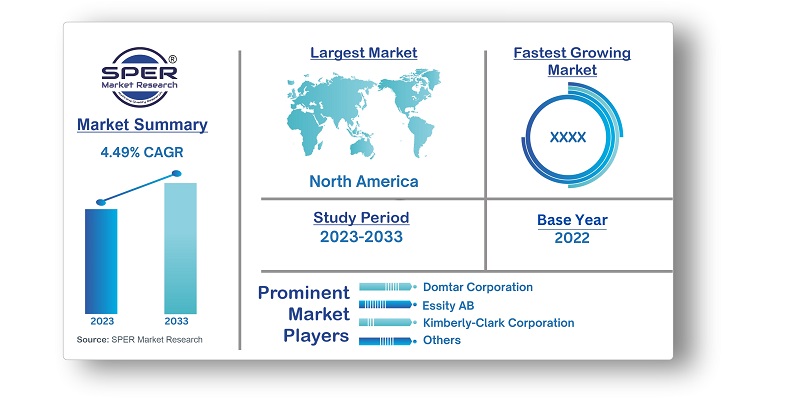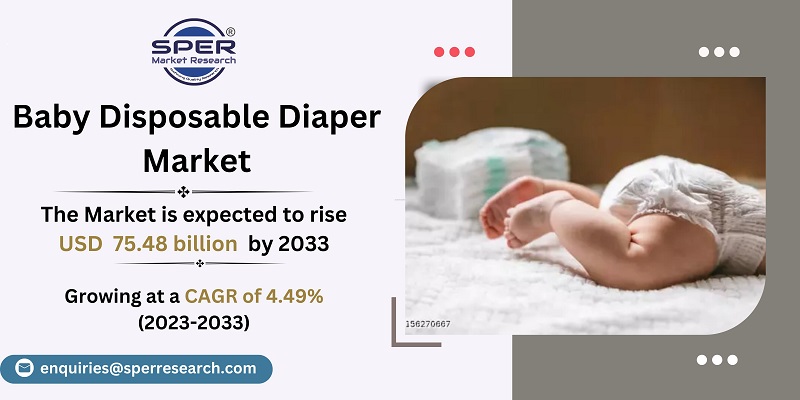
Baby Disposable Diaper Market Growth, Size, Trends, Demand, Revenue, Share and Future Outlook
Baby Disposable Diaper Market Size– By Product, By Type, By Distribution Channel- Regional Outlook, Competitive Strategies and Segment Forecast to 2033
| Published: Feb-2024 | Report ID: FMCG2439 | Pages: 1 - 229 | Formats*: |
| Category : Consumer & Retail | |||
- April 2020: The US-based Corporation Kimberly-Clark, which makes baby diapers and other personal care products, announced that it would buy Softex Indonesia for a sum of $1.2 billion. With this acquisition, Kimberly-Clark increases its presence in Indonesia's developing and rising markets for personal care products.
- May 2021: The "Pampers Pure Protection Hybrid Diapers," which combine the advantages of disposable diapers and environmentally friendly cloth diapers, were introduced by Pampers in May 2021. These are reusable cloth diapers with a plant-based liner-based disposable insert.


| Report Metric | Details |
| Market size available for years | 2019-2033 |
| Base year considered | 2022 |
| Forecast period | 2023-2033 |
| Segments covered | By Product, By Type, By Distribution Channel |
| Regions covered | Asia Pacific, Europe, Middle East & Africa, North America |
| Companies Covered | Domtar Corporation, Essity AB, Hengan International Group Company Limited, Kao Corporation, Kimberly-Clark Corporation, The Procter & Gamble Company, Unicharm Corporation, Fujian Shuangheng Group Co. Ltd., DSG International Ltd., Bambo Nature USA and various others. |
- Parents and Caregivers
- Manufacturers and Suppliers
- Healthcare Professionals
- Government and Regulatory Bodies
- Investors and Financial Institutions
- Marketing and Advertising Agencies
- Non-Governmental Organizations (NGOs)
- Research and Development Professionals
- Educational Institutions
- Environmental Advocates
| By Product: |
|
| By Type: |
|
| By Distribution Channel: |
|
- Global Baby Disposable Diaper Market Size (FY’2023-FY’2033)
- Overview of Global Baby Disposable Diaper Market
- Segmentation of Global Baby Disposable Diaper Market By Product (Disposable, Non-disposable)
- Segmentation of Global Baby Disposable Diaper Market By Type (Organic, Conventional)
- Segmentation of Global Baby Disposable Diaper Market By Distribution Channel (Offline, Online)
- Statistical Snap of Global Baby Disposable Diaper Market
- Expansion Analysis of Global Baby Disposable Diaper Market
- Problems and Obstacles in Global Baby Disposable Diaper Market
- Competitive Landscape in the Global Baby Disposable Diaper Market
- Impact of COVID-19 and Demonetization on Global Baby Disposable Diaper Market
- Details on Current Investment in Global Baby Disposable Diaper Market
- Competitive Analysis of Global Baby Disposable Diaper Market
- Prominent Players in the Global Baby Disposable Diaper Market
- SWOT Analysis of Global Baby Disposable Diaper Market
1.1. Scope of the report1.2. Market segment analysis
2.1. Research data source2.1.1. Secondary Data2.1.2. Primary Data2.1.3. SPER’s internal database2.1.4. Premium insight from KOL’s2.2. Market size estimation2.2.1. Top-down and Bottom-up approach
2.3. Data triangulation
4.1. Driver, Restraint, Opportunity and Challenges analysis4.1.1. Drivers4.1.2. Restraints4.1.3. Opportunities4.1.4. Challenges4.2. COVID-19 Impact of the Global Baby Disposable Diaper Market
5.1. SWOT Analysis5.1.1. Strengths5.1.2. Weaknesses5.1.3. Opportunities5.1.4. Threats5.2. PESTEL Analysis5.2.1. Political Landscape5.2.2. Economic Landscape5.2.3. Social Landscape5.2.4. Technological Landscape5.2.5. Environmental Landscape5.2.6. Legal Landscape5.3. PORTER’s Five Forces5.3.1. Bargaining power of suppliers5.3.2. Bargaining power of buyers5.3.3. Threat of Substitute5.3.4. Threat of new entrant5.3.5. Competitive rivalry5.4. Heat Map Analysis
6.1. Global Baby Disposable Diaper Market Manufacturing Base Distribution, Sales Area, Type, Chassis Type6.2. Mergers & Acquisitions, Partnerships, Type Launch, and Collaboration in Global Baby Disposable Diaper Market
7.1. Global Baby Disposable Diaper Market Value Share and Forecast, By Product, 2023-20337.2. Disposable7.3. Non-disposable
8.1. Global Baby Disposable Diaper Market Value Share and Forecast, By Type, 2023-20338.2. Conventional8.3. Organic
9.1. Global Baby Disposable Diaper Market Value Share and Forecast, By Distribution Channel, 2023-20339.2. Offline9.3. Online
10.1. Global Baby Disposable Diaper Market Size and Market Share
11.1. Global Baby Disposable Diaper Market Size and Market Share By Product (2019-2026)11.2. Global Baby Disposable Diaper Market Size and Market Share By Product (2027-2033)
12.1. Global Baby Disposable Diaper Market Size and Market Share By Type (2019-2026)12.2. Global Baby Disposable Diaper Market Size and Market Share By Type (2027-2033)
13.1. Global Baby Disposable Diaper Market Size and Market Share By Distribution Channel (2019-2026)13.2. Global Baby Disposable Diaper Market Size and Market Share By Distribution Channel (2027-2033)
14.1. Global Baby Disposable Diaper Market Size and Market Share By Region (2019-2026)14.2. Global Baby Disposable Diaper Market Size and Market Share By Region (2027-2033)
14.2.1. Asia Pacific
14.2.2. Europe14.2.3. Middle East & Africa14.2.4. North America
15.1. Bambo Nature USA15.1.1. Company details15.1.2. Financial outlook15.1.3. Type summary15.1.4. Recent developments15.2. Domtar Corporation15.2.1. Company details15.2.2. Financial outlook15.2.3. Type summary15.2.4. Recent developments15.3. Essity AB15.3.1. Company details15.3.2. Financial outlook15.3.3. Type summary15.3.4. Recent developments15.4. Fujian Shuangheng Group Co. Ltd.15.4.1. Company details15.4.2. Financial outlook15.4.3. Type summary15.4.4. Recent developments15.5. Hengan International Group Company Limited15.5.1. Company details15.5.2. Financial outlook15.5.3. Type summary15.5.4. Recent developments15.6. Kao Corporation15.6.1. Company details15.6.2. Financial outlook15.6.3. Type summary15.6.4. Recent developments15.7. Kimberly-Clark Corporation15.7.1. Company details15.7.2. Financial outlook15.7.3. Type summary15.7.4. Recent developments15.8. Unicharm Corporation15.8.1. Company details15.8.2. Financial outlook15.8.3. Type summary15.8.4. Recent developments15.9. Others
SPER Market Research’s methodology uses great emphasis on primary research to ensure that the market intelligence insights are up to date, reliable and accurate. Primary interviews are done with players involved in each phase of a supply chain to analyze the market forecasting. The secondary research method is used to help you fully understand how the future markets and the spending patterns look likes.
The report is based on in-depth qualitative and quantitative analysis of the Product Market. The quantitative analysis involves the application of various projection and sampling techniques. The qualitative analysis involves primary interviews, surveys, and vendor briefings. The data gathered as a result of these processes are validated through experts opinion. Our research methodology entails an ideal mixture of primary and secondary initiatives.



Frequently Asked Questions About This Report
PLACE AN ORDER
Year End Discount
Sample Report
Pre-Purchase Inquiry
NEED CUSTOMIZATION?
Request CustomizationCALL OR EMAIL US
100% Secure Payment






Related Reports
Our Global Clients
Our data-driven insights have influenced the strategy of 200+ reputed companies across the globe.




















